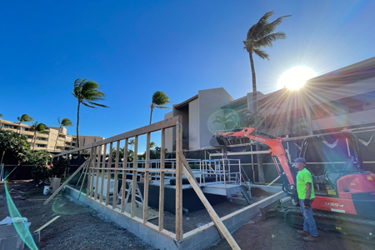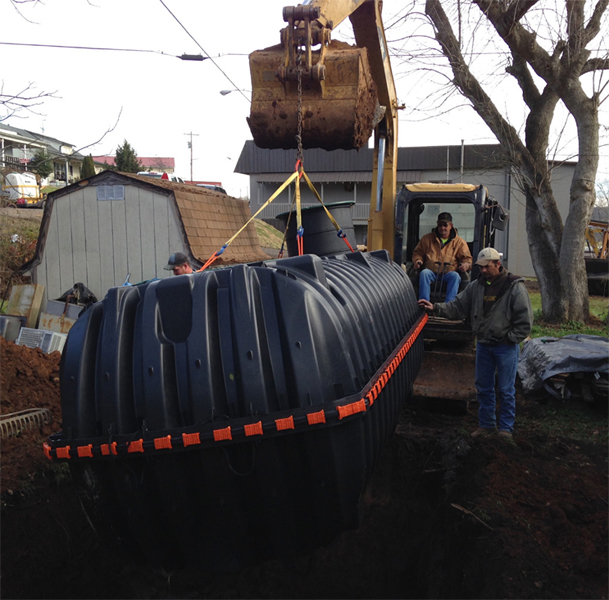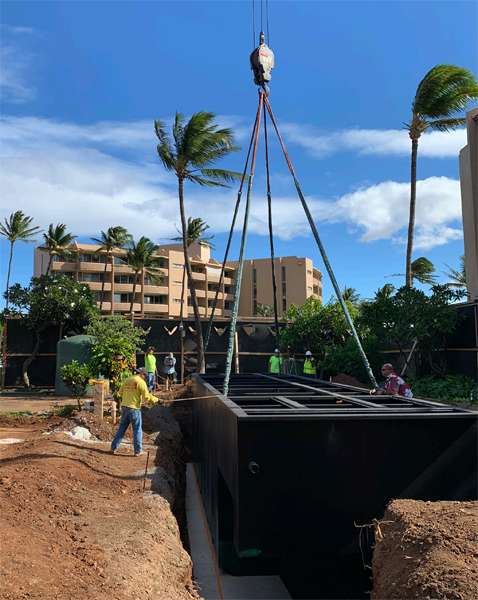Best Practices For Decentralized Wastewater Treatment System Upgrades And Replacements
By Dennis Hallahan

Onsite wastewater treatment solutions are practical and popular, but changing regulations and conditions may require an update to operations.
Wastewater is not typically discussed at the dinner table and most people take wastewater treatment for granted, preferring to flush and forget. This makes the work by wastewater professionals, regulators, and health departments to protect public health and our water resources even more challenging. Wastewater treatment, both residential and commercial, is a community concern. The topic needs to be more widely discussed, including the value that a comprehensive plan to keep community wastewater treatment systems working properly can have on tourism, recreation, increased business, quality of life, preservation of fishing and shellfish beds, and other tangible benefits.
In communities located in highly sensitive watershed or other environmentally sensitive areas, regulators and residents are more keenly aware of the values of their local water resources and have a heightened awareness of the issues that result from outdated or underperforming wastewater treatment systems. These areas are instituting more stringent regulations and working together as a community to access funding and educate the public about what needs to be done and the options available. For example, lake associations in upstate New York have adopted higher levels of treatment to protect the lakes from wastewater pollution. Suffolk County, NY, has adopted higher levels of treatment to address nitrogen concerns. And there are several other “hot spots” throughout the nation: coastal estuaries in Cape Cod and Rhode Island, the many springs of Florida, and the Chesapeake Bay, to name a few.
As a result of regulatory enforcement orders or proactive communities, requirements to upgrade or replace underperforming or failing existing onsite systems are being enacted. This is not easy and is often unpopular. The community may be divided about the issues, the extent of the requirements needed, and, most importantly, the cost burden as community leaders juggle the options, including centralized versus decentralized treatment designs. When a costly centralized sewer option is heavily pushed, not only is the overall cost a burden on taxpayer dollars, but the individual cost to connect to a centralized system is often more than many residents can or want to bear. Further, the centralized option brings with it a plethora of secondary concerns for the community: increased residential density, larger commercial facilities, increased traffic, loss of character of the town, and continual increases in user rates that are out of the hands of the homeowners. This has catalyzed new technology and creative system designs that can solve wastewater challenges and do so using a decentralized approach with less infrastructure and most often lower cost.
The decentralized option has its challenges as well. It can be more difficult to obtain funding for decentralized treatment, and the old, small, lakeside/coastal lots may have preexisting, nonconforming lot sizes and may not have room to fit conventional code-sized onsite wastewater treatment systems. That’s where creativity on the part of the system designer comes in, and that often includes elements taken from both the decentralized and centralized treatment playbook.
Selecting The Best Approach For Individual Community Needs
Let’s say that the community has hired a consulting engineering firm to investigate options to address the environmental concerns with a wastewater plan. The plan offers two alternatives: sewering or a decentralized approach. Each alternative should be investigated, as no two communities are alike and the best solution for each will vary. A strong public outreach campaign is important throughout the process to keep residents apprised of the progress and to ultimately help them make the choice to approve the best option for the community.
The Decentralized Path To Treatment
For the purposes of this article, we are going to focus on the decentralized option. In these cases, it is common that upgrades and/or replacements to a significant percentage of the systems in the community may be needed to meet new regulations, and difficult situations will arise. It is best to conduct a site-by-site accounting of each home’s or business’ existing system. Visiting each site is a time to engage homeowners and business owners and to get buy-in from them. It’s also a chance to have a questionnaire for them to complete and to hear their concerns. Once there is a legitimate wastewater-induced problem identified, it must be conveyed and communicated to the public along with the public benefit from the investment in new systems. It suffices to say that the residents’ greatest concern will be how much it will cost and whether there is any funding or loans available to offset the individual system owner’s expense.

At Surgoinsville, TN, the difficult Appalachian sites with steep slopes and limited backyard access to existing homes made system design and installation challenging. Ultimately, individual STEP services were installed at more than 200 residences. The ease of handling the plastic tanks in tight quarters made them the ideal solution.
If the home or business owner is not convinced there is an environmental problem, it will be a difficult process. For example, if a homeowner or business recently had a new code-conforming system installed at great expense, the current system could be fine, or it may need to be upgraded to include some form of advanced treatment to meet new regulations and conform with the town requirements. That wastewater treatment system owner is going to push back strongly against those new upgrades and the cost to complete them.
Decentralized Options For Upgrades And Replacements
Repair and replacement standards, codes, and regulations differ by state and province. Upgrades and replacements can take many forms and there are many solutions available. If there is room on the site, then an advanced treatment system (ATS) can be installed with a disposal field. Many types of treatment systems are available, and the approved ATS varies per regulations. For small, undersized, tight lots it may be best to install septic tank effluent pumping (STEP) systems to convey the effluent to a remote site that has available area, good site and soil conditions, and is located away from the sensitive waterbody. The point is that the options are varied, and understanding the area and the individual sites within it is the only way to make the best recommendation.
Best Practices To Assess Wastewater Treatment Needs And Evaluate Design Options
- Understand local codes, including special regulations for environmentally sensitive locations.
- Determine current effluent volume, anticipated future needs, and effluent strength.
- Ask about intermittent or seasonal flows and usage patterns.
- Evaluate the current system size and the footprint available for a new system or upgrade.
- Establish the optimum treatment levels to attain based on usage, effluent strength, daily flow, and location.
- Research any existing site and soil conditions that could affect system selection, performance, and longevity.
- Ascertain if there is a current system O&M provider; if not, research options in the area.
All of these variables are important and play a significant role in the decision-making process around individual and community systems. One of the most important that has been overlooked for years is the operations and maintenance element. All systems require maintenance, even the most standard septic tank and drainfield designs. For ATS systems, maintenance contracts are a necessity. They can be with the individual home or business owners, homeowners association, or the utility district. These contracts should be a part of the plan from the start to ensure that the systems will perform as intended and will meet the regulatory permit requirements. After all, one of the selling points for communities to embark on a wastewater treatment upgrade is to enhance performance and safe operation over the longest period of time possible.
Regulations Respond To Developing Technology
As is the case with Suffolk County and other states and provinces, regulators have embraced new products and engineered wastewater treatment solutions by adjusting codes to reflect the increased performance of new products, including the higher throughput rates of aggregate-free products such as plastic-leaching chambers and engineered geosynthetic aggregate. The scientific research findings and third-party performance testing data are helping regulators to be proactive to the benefit of the communities they serve, which benefit from the inclusion of advanced treatment systems in their wastewater arsenal.
Individual And Community Wastewater Treatment Upgrade/Repair Examples
Alternative Onsite Wastewater Treatment System Project
An example of forward thinking in action is Suffolk County, NY. Nitrogen from residential septic systems has been identified as a significant factor in the degradation of Long Island estuaries. Sewering most of the county was investigated and determined to be financially unfeasible. Therefore, the Suffolk County Health Department has been very proactive instituting a septic demonstration program that will implement advanced treatment technologies and shallow dispersal drainfields to reduce nitrogen. In addition, the county sanitary code has been upgraded to allow for these changes. The demonstration program results in a public-private partnership where manufacturers donate systems as part of the program.

When the Lauloa Maalaea Resort in Hawaii was required to update its wastewater treatment unit due to tighter effluent requirements required in a forthcoming permit update, the new system had to maintain the same footprint of the existing below-grade treatment unit that was being replaced.
When New York listed portions of the Long Island Sound, Peconic Estuary, and South Shore Estuary as impaired waterbodies, Suffolk County officials began a review to understand the source of the water supply pollution. Seventy-four percent of Suffolk County utilizes onsite sewage disposal systems. Currently, the drainfield systems in Suffolk County consist of deep leaching pits, cesspools, concrete rings, or leaching pools that can be installed as deep as 25 feet. A study revealed numerous pollution sources; however, nitrogen pollution from cesspools and septic systems was identified as the primary cause of water-quality issues. Impacts include beach closures, toxic algae blooms, and shell fishing restrictions, which are all detrimental to resident health and tourism.
Since sewering was unfeasible, the Suffolk County Health Department participated in the “Reclaim Our Water Initiative,” focused on reducing nitrogen by replacing existing septic systems with alternative onsite wastewater treatment systems (AOWTS). The initiative includes a demonstration program to pilot these advanced treatment technologies. In this public-private partnership, manufacturers donate the systems, including advanced treatment technologies and shallow dispersal drainfields, to the demonstration program. Tested and monitored by the county for six months, if the system meets the county “pass criteria” standard of a 50 percent reduction in nitrogen, it gains Provisional Use Approval. The county also upgraded its sanitary code to allow for the changes needed to incorporate these advanced technologies.
STEP Systems Replace Failing and Compromised Subsurface Disposal Systems
Surgoinsville was one of the few municipalities in Tennessee without a public sewer system, limiting economic development opportunities. Existing homes were served by subsurface sewage disposal systems that were failing and compromised by other factors, including structures built over these systems. The existing package plant, in operation since 1959, served the Surgoinsville elementary and middle schools and was at the end of its useful life. The town decided to pursue a sewer system that could handle current needs with capacity for the future.
The $4.5 million project serves 247 residences, two schools, and nine businesses. Installed on lots with existing homes, outbuildings, driveways, and landscaping, the project was designed with the additional capacity to serve approximately 700 properties. The low-pressure sewer system delivers wastewater to the city of Church Hill’s wastewater plant. The system comprises approximately nine miles of low-pressure sanitary sewer collection lines, two pump stations, and individual STEP services at more than 200 residences that include Infiltrator IM-Tanks. Difficult Appalachian sites with steep slopes and limited backyard access to existing homes made tank installation challenging, and the ease of handling of the plastic tanks provided the ideal solution. As well, the tanks were delivered to the installer’s onsite staging yard nested, and the staff assembled the tanks as needed to complete the project. This saved time and space prior to installation.
Extended Aeration Unit Solves Wastewater Treatment Challenges at Resort
The Lauloa Maalaea Resort in Hawaii was required to update its wastewater treatment unit due to tighter effluent requirements required in a forthcoming permit update. The existing treatment unit to be replaced was installed below grade in the resort’s parking lot. Due to limited space on the site, this was also the only possible location for a new system, so the new system had to maintain the footprint boundaries of the existing system. To meet the new regulation requirements and handle the design flow of 21,000 GPD, the resort selected a new extended aeration treatment unit. The old treatment unit was completely removed from the site, followed by the placement of a foundation on which the new treatment system was installed. To ensure the treatment unit was out of sight, secure, and aesthetically pleasing, a building was constructed around the unit. The extended aeration process selected for this system utilizes aeration followed by clarification and disinfection.
The flow equalization chamber receives the incoming wastewater, then duplex pumps discharge the wastewater into the aeration chamber. Duplex positive displacement blowers and an air distribution manifold system supply all the air needs to the system, including air diffusers, airlift pumps, and a scum skimmer. The hopper-style clarifier chamber has baffling to prevent short-circuiting and to provide the maximum uniform solids-settling area. The settled sludge returns from the clarifier floor sludge well to the aeration chamber by the positive sludge return system. Immediately following the clarifier is a plug flow chlorine contact chamber. The influent characteristics were typical domestic waste loadings, with typical effluent requirements of less than 20 mg/L of biochemical oxygen demand/ total suspended solids (BOD/TSS).
Conclusion
Decentralized wastewater treatment system upgrades and replacements offer many solutions to protect our water resources. One important consideration is that the water is returned to the local aquifer for recharge, thereby supporting the natural ecosystem. Thorough planning and design by a licensed firm with decentralized experience can open up the possible solutions that provide high performance that might have been overlooked. There are technologies available today to address the wastewater constituents of high concern such as nitrogen or phosphorus and/ or to meet site constraints such as high water table, small lot size, or difficult soils. The fact that there are many solutions is the easy part. The hard part is getting the community together to agree on a plan and approve it. To that extent, as much time and energy should be focused upon community education and communication as it is with the engineering plans. Meetings with key groups, mailings, clear objectives, and goals listed on a community project website for anyone to access are all simple, but they go a long way toward gaining the support needed to move forward. Without community support, the project will not survive, and fines and mandates from those outside the community, along with the environmental detriments of inaction, can be devastating.
About The Author
 Dennis Hallahan has more than 30 years of experience with onsite wastewater treatment systems design and construction. Currently the technical director at Infiltrator Water Technologies, he is responsible for technology transfer between Infiltrator and the regulatory and design communities, and he consults on product research and testing for universities and private consultants. Dennis received his MS in civil engineering from the University of Connecticut and his BS in civil engineering from the University of Vermont. He is a registered professional engineer in Connecticut and holds several patents for onsite wastewater products. Email: dhallahan@infiltratorwater.com.
Dennis Hallahan has more than 30 years of experience with onsite wastewater treatment systems design and construction. Currently the technical director at Infiltrator Water Technologies, he is responsible for technology transfer between Infiltrator and the regulatory and design communities, and he consults on product research and testing for universities and private consultants. Dennis received his MS in civil engineering from the University of Connecticut and his BS in civil engineering from the University of Vermont. He is a registered professional engineer in Connecticut and holds several patents for onsite wastewater products. Email: dhallahan@infiltratorwater.com.
